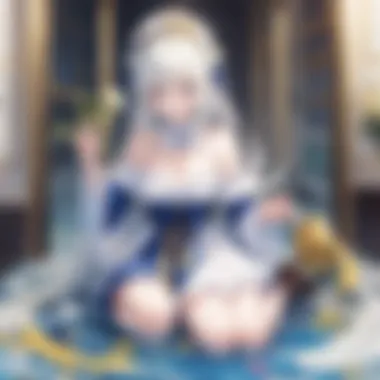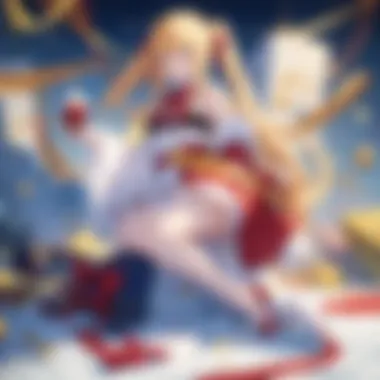Where Happiness Lives: Analyzing Joy in Anime and Manga


Intro
Happiness within the realms of anime and manga transcends mere emotion; it encompasses a myriad of experiences that invite analysis. This exploration endeavors to unravel how joy and contentment manifest through themes, narratives, and characters crafted in this unique cultural medium. As we traverse distinct environments, emotional arcs, and creator intentions, an intricate tapestry of well-being emerges.
In anime and manga, undercurrents of warmth and happiness are found in unexpected places, be it within the serene landscapes of a slice-of-life series or the intense character development present in action-packed narratives. Characters often experience profound transformations influenced by their journeys, shedding light on the meticulous crafting of happiness in their lives.
Central to this discourse is the recognition of how these works reflect and shape societal perspectives on well-being. By delving into personal stories, audience connection, and psychological resonance, we can appreciate the profound impact anime and manga have on their viewers.
The subsequent sections will offer a structured examination of this theme, encompassing character spotlights, narrative analyses, and comparisons between various adaptations. Each piece adding layers to our understanding of happiness within these narratives. Let us now delve into the first section.
Understanding Happiness
The topic of happiness serves as a foundational theme in anime and manga, influencing how narratives are constructed and characters interact. It is essential to comprehend what happiness means in the context of these forms of art, as well as its broader implications for the audience. Examining happiness provides insight into emotional resonance, encouraging viewers to reflect on their own experiences in a digital world often interlaced with fantasy.
Understanding happiness is not only about feeling joy but also involves recognizing emotional complexities and the journey towards contentment. This nuanced exploration can illuminate character motivations and story progressions, bringing the audience closer to thematic revelations. Moreover, articulating what happiness signifies within these cultural works invites personal growth and external discussions surrounding mental well-being. In this discussion, we dissect happiness into critical components that function symbiotically to elevate the storytelling richness.
Defining Happiness
Defining happiness proves to be a multifaceted endeavor. Within anime and manga, happiness goes beyond mere surface-level contentment; it frequently embodies emotional fulfillment, acceptance, and a serene state of being. Various series present happiness through character relationships, achievements, or milestones.
A precise definition may encompass:
- Temporary Joy: Fleeting moments that resonate with joy, influenced by events or relationships.
- Enduring Contentment: A steadier state of satisfaction achieved through overcoming trials.
- Interpersonal Connections: Bonds with friends, family, and even rivals that elevate the overall sense of well-being.
How the narratives shape these dimensions significantly affects audience interpretations and their own acknowledgments of happiness.
Philosophical Perspectives on Happiness
Philosophical discourses on happiness date back to ancient thinkers. Many have pondered the essence of a happy life, debating intrinsic and extrinsic factors involved. Works from figures like Aristotle and Epicurus present frameworks where the notion of happiness relates closely to virtues, fulfilling one's purpose, and finding balance.
In the realm of anime and manga:
- Virtue and Purpose: Series often showcase characters on quests for internal or external validation, reflecting on their deep values.
- Solitude and Happiness: Many explore just how solitude influences happiness, portraying protagonists finding contentment within themselves.
Philosophical reflections echoing through these works provide discerning viewers guidance to rethink invested perceptions, causing them reevaluate what true fulfillment entails.
Cultural Interpretations of Happiness
Cultural contexts inherently shape the understanding and depiction of happiness in anime and manga. Aspects such as societal values, historical influences, and relevant traditions impart varriations in how happiness is perceived and valued. For instance:
- Japanese Perspectives: Rooted in collectivism, happiness is interwoven with family ties and community welfare.
- Hyper-individualism: Certain narratives manifest characters whose pursuits reflect a more self-centered understanding of contentment.


It’s crucial to notice these dynamics as they reveal the influences cultural factors can have on perceptions of well-being. The diverse interpretations require participation from audiences who may define happiness differently because of their backgrounds and experiences.
Understanding happiness in the framework of anime and manga goes beyond straightforward enjoyment, delving into deeper influences on society and individual consciousness.
In summation, the quest for happiness, viewed through various lenses, underscores a narrative strength within these strategic forms of art, allowing for a conscientious engagement from the global audience.
Fictional Worlds in Anime and Manga
The exploration of fictional worlds reveals much about how environments can shape happiness in narratives. Anime and manga often serve distinct roles, from engaging the viewer to providing escapism.
Exploring Magical Realism
One major aspect is Exploring Magical Realism, a genre that seamlessly blends the ordinary with extraordinary occurrences. Once isolated from reality, it marries whimsy to tradition, casting characters into unusual scenarios while defending vital emotional response. The main characteristic of this genre is its ability to surprise without fraying the bonds of reason.
In terms of advantages, it allows for nuanced portrayal of success measures beyond social norms, engaging its audience through a mix of joy that often coexists with hardship. However, dependence on tropes could lead to a disconnection from more common experiences through fantasy.
Everyday Settings in Slice of Life
Another influential aspect of the depiction of happiness is Everyday Settings in Slice of Life. Slice of Life narratives frequently capture the mundanity of life, celebrating simple moments of joy rather than grand adventures. The real charm resides in its groundedness and relatability; characters explore their daily lives and pilot emotions through sort of mundane challenges it brings along.
What sets Slice of Life apart is how it recognizes the significance of small achievements, highlighting them to derive pleasure from them. This accessibility and plain nature also prove its most significant benefits but can result in potential drawbacks by lacking plot momentum adopt thrilling scenarios that ensue in broader genres.
Community and Connection
The importance of community and connection resonates strongly across anime and manga, enriching the narrative but grounding it further into reality. Characters thrive and stave off struggles when they leverage friendships, families, or even their physical communities. They provide emotional support and solid boundaries while allowing for growth experience through collective highs and lows. Therefore, environments inevitably gear behaviors forming bonds and laying platforms for shared experiences and satisfaction.
In essence, characters flourish when enveloped by strong social structures within welcoming spaces. Where connection thrives, so does the latent happiness dwelling deep within fictional worlds. Finding these layers offers insightful commentary on patterns reflective of readers' own lives.
Character Arcs and Happiness
Character arcs serve as crucial vehicles for exploring the theme of happiness within anime and manga. A coherent character journey allows anime and manga to decirbe personal experiences of joy, loss, and growth, providing audiences with situations they might resonate with. Ultimately,these character developments illustrate the myriad pathways one may traverse toward happiness, often focusing on the nuances of personal transformation and emotional evolution. The interaction between protagonists, supporting characters, and even antagonists paves the way for various definitions and interpretations of happiness.
Protagonists' Journeys
From Struggle to Contentment
The narrative arc of moving 'From Struggle to Contentment' preserves a unique relevance, allowing storytellers to portray the real struggles faced by characters. It mirrors human experiences, linking characters' challenges to our own challenges. This characteristic deeply roots audiences in the emotional journey of identifying with the protagonist’s situation, enriching the relatability of the overall storytelling.
By showcasing characters cultivate strength through conflicts, this journey answers the fundamental question of what contentment truly means in the context of anime and manga. The psychological acknowledgment of inner fights often leads to resolutions that reflect growth and happiness. For this reason,
Storytelling Techniques and Happiness
Storytelling techniques play a crucial role in conveying happiness in anime and manga. These methods shape the narrative, allowing viewers to connect emotionally with characters and their experiences. As stories unfold, techniques not only illustrate happiness but also create an atmosphere where viewers can experience joy vicariously. An effective story can resonate deeply, making moments of happiness impactful and memorable.


Narrative Structure and Emotional Impact
A well-crafted narrative structure is essential to evoke emotional reactions in the audience. In anime and manga, the pacing and flow of the plot not only engage viewers but also affect how happiness is perceived. For example, rising action builds anticipation, providing moments of tension that highlight subsequent joyful resolutions, enriching the sense of satisfaction when characters experience happiness.
The emotional impact of storytelling hinges on how conflicts are presented and resolved. When characters face struggles, experiencing bleak moments before attaining happiness, audiences can relate more profoundly. This journey resonates with real-life struggles, tapping into shared human experiences. The outcome fosters a larger understanding of happiness, highlighting it as something earned through perseverance.
Visual Storytelling Elements
Visual components are just as vital, adding layers of meaning to narratives. These elements offer immediate audience engagement while conveying complex themes associated with happiness.
Color Theory
Color theory serves as a powerful tool in portraying mood. Priamry colors can evoke clear emotions; for instance, warm hues like yellow and orange often signal joy, safety, and warmth. These shades align with narratives highlighting happiness in a bright, positive manner, making it a preferred choice in cheerful settings.
On the other hand, subdued tones might denote nostalgia or calm, presenting happiness in subtler contexts. The unique aspect of color theory lies in its universality. It is a visual language understood across cultures, enhancing storytelling's reach. However, excessive saturation can overwhelm and diminish the intended emotional response if not used carefully.
Symbolism in Art
Symbolism in art serves another enriching layer in storytelling. It encapsulates broader meanings, allowing an audience to associate specific objects or colors with happiness. For instance, the continuous motif of cherry blossoms in numerous works represents transient beauty, encapsulating fleeting moments of joy.
This method enables creators to layer narratives which prompt reflection. However, reliance on symbolism can lead to confusion for those unfamiliar with particular cultural references. Nonetheless, when utilized effectively, it makes the artwork resonate on multiple levels, providing a rich tapestry of insights into happiness.
Music and Soundtrack Contributions
Sound and music fortify the storytelling experience. The right soundtrack can elevate emotional impact, setting the tone for moments of happiness. Melodic themes, when woven throughout scenes, enhance viewers' connection to characters and their journeys. Music changes fleeting expressions into lasting feelings, deepening engagement.
Healing and Therapy in Anime and Manga
The realm of anime and manga is rich with emotional depth and often explores themes of healing and therapy. This section emphasizes the significance of these themes as vehicle for understanding happiness. Many narratives allow viewers and readers to witness characters undergoing growth and recovery from emotional pain. Through these experiences, audiences may find relatability or simply solace in knowing they are not alone in their struggles. Engaging with such stories shapes the perception of happiness in powerful and nuanced ways.
Art as a Medium for Healing
Art, in all its forms, has always held the potential to heal. In anime and manga, art transcends mere aesthetic pleasure. Characters express their vulnerabilities, and their journeys reflect common human experiences of grief, hope, and reconciliation. The animation style or art can capture subtle emotions, allowing viewers to empathize deeply with characters.
Platforms like MyAnimeList provide forums where enthusiasts analyze how specific scenes bring out emotions and inspire discussions on healing through storytelling.
Benefits of Art as Therapy
- Emotional Release: Each frame, color, or scene can stir emotions that resonate with individual experiences, promoting catharsis.
- Understanding and Reflection: Viewers may find relatable moments that prompt self-reflection and understanding of their inner feelings.
- Connection to Others: Characters often depict struggles, yet also highlight resilience. This connection can enlighten viewers on shared vulnerabilities and successes.
Case Studies of Transformative Stories
Now, let’s examine notable examples where anime and manga effectively communicate themes of healing.
- A Silent Voice explores the story of Shoya, a former bully seeking forgiveness. The narrative showcases healing achieved through understanding and reconciling past actions. It transcends simple depictions of remorse; it resonates with profound insights about forgiveness and change.
- March Comes in Like a Lion focuses on Rei, a shogi player combating depression. The careful development of Rei’s intimate relationships highlights how support, empathy, and meaningful connections can facilitate healing processes.
- Your Lie in April presents piano prodigy Kōsei, who grapples with trauma and loss after his mother’s death. With the help of the spirited Kaori, he embarks on a journey of emotional healing, finding his voice and passion for music again.


These narratives showcase how themes of healing and therapy in anime and manga affect viewers’ perceptions of happiness. They redefine what well-being means, blending personal and universal experiences.
Through these case studies, we see that art in anime and manga not only entertains but also acts as a crucial medium for addressing mental health issues. While often done through subtlety, the aim remains clear: to promote understanding, healing, and ultimately a representation of happiness shaped by personal growth.
The Audience's Connection to Happiness
Understanding audience perceptions of happiness in anime and manga is pivotal. It provides insight into how these stories resonate and influence viewers. Happiness, as represented in these works, can foster empathetic connections between audiences and characters.
Viewer Perceptions of Happiness
Viewer experiences shape how happiness is interpreted in anime and manga. Each individual may relate differently to themes presented. For some, happiness involves peaceful moments shared with loved ones. Others might celebrate personal achievements portrayed in the narratives.
These varying viewpoints are enriched by cultural background, life experiences, and emotional states. This diverse array of influences results in unique interpretations, leading to conversations about what constitutes happiness and well-being. Presenting emotional arcs and joyful moments allows viewers to find meaning relevant to their own lives. Through understanding viewers' responses, creators can delve deeper into authentic happiness and the multifaceted aspects of human experiences.
People find joy especially in the characters who reflect their own struggles and triumphs.
Community Engagement and Shared Joy
Communities formed around anime and manga share their interpretations widely. Fans interact through online platforms such as Reddit and Facebook, often forming bonds while discussing narratives and characters that resonate with their sense of happiness. Collaborative analysis fosters a sense of belonging among viewers.
Engagement occurs via fan art, cosplay, discussions, and theories. These contributions enhance viewers' connections to the content and to each other. Shared joy often becomes cultivated in online fandoms, where perspectives stretch narratives beyond the screen. Participating in these communities nurtures collective happiness, emphasizing how art influences social dynamics.
Fan Interpretations and Reactions
Fans are not just passive consumers. They actively engage with themes, interpreting what the impact of different stories means to them. Reactions to characters and storylines reflect personal sentiments. Appreciation for specific arcs or details builds personal connections to abstract beliefs surrounding happiness.
For instance, anime such as My Hero Academia showcases the perseverance needed to achieve one’s goals. Views on these particular pathways to joy influence fan dialogues. Through expressive analyses, fans convey how these narratives shift their perceptions of happiness itself. This aspect of fandom highlights how closely viewers relate to themes and messages presented by authors.
Overall, the interactions between anime, manga, and the audiences create space for deeper emotional responses that reflect an intricate understanding of happiness itself.
Concluding Thoughts on Happiness in Anime and Manga
Examining happiness in anime and manga illuminates how these forms of media serve not only as entertainment but also as mirrors to our own contentment and sense of well-being. The representations of joy, sadness, and everything in between are complex and varied, reflecting an intricate dance of cultural norms and personal aspirations. As we focus on the concluding parts of this exploration, several important elements emerge that deserve attention.
The Future of Happiness Representation
Happiness representation in anime and manga is evolving continually. With shifts in societal values, media content can adapt in an innovative way to reflect ongoing changes. Here are some key considerations for the role of happiness in future narratives:
- Changing Narratives: As more creative voice emerge, we may encounter new story arcs reflecting diversity in happiness expectations and emotional expression.
- Global Influence: The spread of anime and manga outside Japan means that happiness depictions will integrate motifs from various cultures. This dynamic is enriching the narratives and bridging emotional understandings.
- Critical Narratives: With increasing awareness of mental health, stories are now more likely to address not only the pursuit of happiness but also the struggles associated with finding it. Serious themes may dance with the more light-hearted to offer a balanced view.
The future surely holds potential for great depth. Innovating artists might reveal what happiness truly means to them, encouraging the audience to reflect on their own experiences. In many case studies of character development, future happiness narratives may well reveal more about interpersonal relationships and collective joy.
Final Reflections
Looking back at our exploration of happiness in anime and manga brings up insightful reflections. Throughout this article, it is evident how deeply interconnected narrative environments, character growth, and audience engagement are in shaping perceptions of happiness. A few takeaways highlight this connection:
- Resonating Spaces: Paintings of utopian towns, gritty urban streets, and cozy homes reflect spaces that invoke various feelings. Audiences identify these places immediately, adding to their emotional investment in the characters.
- Character Growth Emphasis: The journeys of protagonists, victors over their conflicts and embracing joy, underscore a human experience. Reinforcing the message that happiness is often found through adversity can inspire readers seeking their own meaning.
- Cultural Layers: Cultural undertones enrich stories. Such reflection acknowledges how individuals from multi-faceted backgrounds may connect with themes of happiness in unique ways.
By blending cultural integrity with engaged viewer experience, anime and manga can demonstrate significant weight in actual socio-emotional learning. Not just confined to the Japanese experience, the conversation about happiness is vital regardless of the viewer's background, promoting understanding across cultural divides. Through continued exploration, perhaps we can further discover how joy truly exists in both our realities and fictional narratives.







